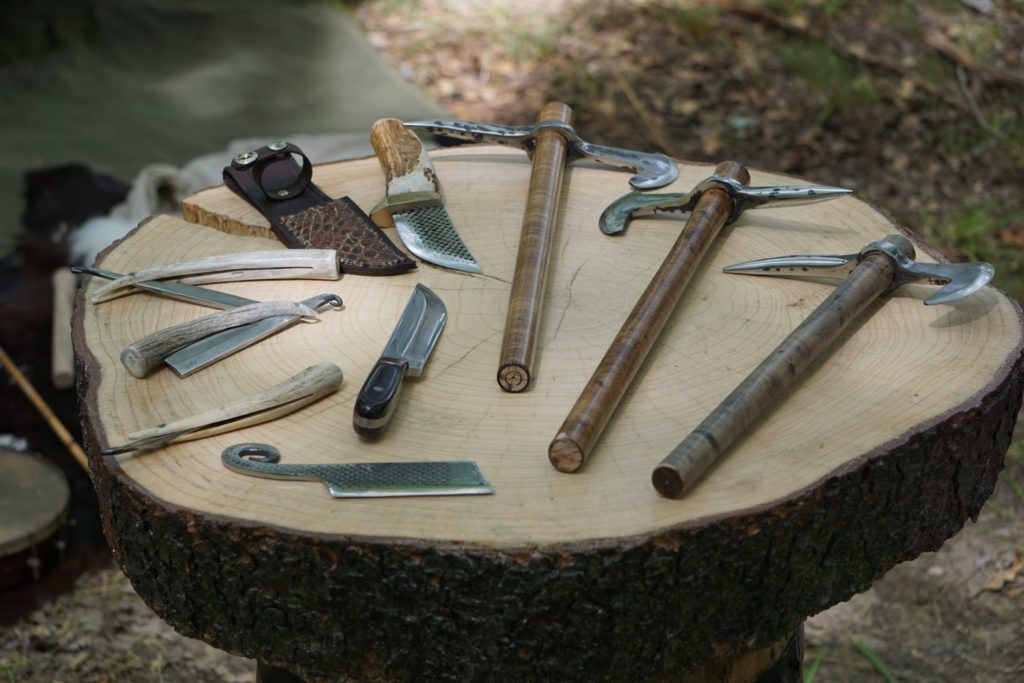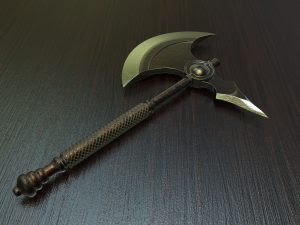In history, an axe is known for various uses like felling trees, hunting animals, and as a weapon. Today, it is used in outdoor pursuits like camping; the types of axes depend on their purpose.

Having a specific axe designed to tackle a specific job makes the difference without putting your life at risk, and you also make your work easier and safe. The head is what determines the use of an axe, but the handle and shape also matter.
The most common use for an axe is chopping wood, and the most popular piece is the American axe used for felling. Here are the main purposes for different types of axes:
- Timber harvesting
- Shape, split or cut wood
- Heraldic symbol
- Ceremonial symbol
- Weapon
Types of Axes and their uses
1. Battle Axe
The battle axe is much smaller than the Viking Axe because it is meant to be handled by one hand. It is used as a weapon, and it carries much power when you swing it toward your enemy or target. There are industry manufacturers who design the battle collection, making it easier to get one if you are interested.

2. Tactical Axe
The axe is a jack of all trades mastering none, but, it is quite useful to campers and survival people. It is not made of hickory or wood but steel and has helpful notches with serrated edges for specific tasks.
Climbing axes are a good example of tactical axes as they feature special cutouts to cut through rocks or catch bolts. In a survival situation, an excellent one is handy due to its strength and multi-functional purpose.
3. Viking / Danish Axe
The Viking piece is also known as danish, but there are no specific uses for them. You will find that the battle enthusiasts also equip themselves with Vikings, so finding yourself a piece is no hassle. The normal size for a Viking is huge, measuring up to six feet, and they come in different sizes depending on their use, and you can even fit one for yourself. There are Vikings boots and boots sold separately.

4. Grub Axe
It is otherwise known as a ‘cutter mattock,’ with a head and adze to the end. Its blade is at a vertical angle, and the adze blade is at a horizontal angle, and it is the longer one of the two.
Its name comes from the way it is used: The piece is handy for grubbing compacted soils and rough terrain. Gardeners find this tool quite useful for digging holes for new plants in or breaking the resistant roots of older plants.
5. Felling Axe
These are the most popular, and it is unlikely you miss them in a home for chopping and felling trees. Its long handle gives more power to the user when swinging it as great leverage to make a better cut.
Typically, hickory wood is used to make the handle because it is strong. The hickory grain should be placed in such a way that it follows the handle lengthwise curving along with its strength.
The blade is flared and sharp and its tip is thin, a design like that of a felling axe for cutting against wood grains. It is swung sideways at the tree trunk not downwards when cutting a tree. They perform their duty excellently, but their blades are not good for splitting because they get stuck in the wood.
6. Hudson Bay Axe
It is of medium size, and Canadian fur trappers designed it for chopping firewood on their trips to the cold north. Also, they can be an all-purpose axe across different tasks.
Its size is in between a hatchet and a felling axe, and it can be used with one or two hands. The axe is good for chopping and splitting smaller wood, and the size is favorable for camping trips.
7. Splitting Maul
They are ideal for splitting logs and they resemble felling axes and a long wooden handle for a perfect swing. When using it, swing it downwards not sideways like when using a felling axe.
Felling axes are cut against the wood grain but this one cuts along the grain, hence why it is ideal for splitting other than chopping. A splitting maul has a heavier head than the felling counterpart by around eight pounds.
The head’s shape is of a chunky wedge, one end is sharp, and the other is blunt. Its weight and shape in the blade are what matters meaning it doesn’t have to be sharp to function. Because of this fact, they don’t have to be sharpened often as they work well even when blunt.
Conclusion
Like any other tool, it is important to know what you want to do with it. Since there are many types of axes, having the right one designed for the right job makes the difference when working. It also ensures your safety and proper performance of whatever task.
READ MORE: Which Part Of A Modern Firearm has the Same Function As The Lock On a Muzzleloader?




